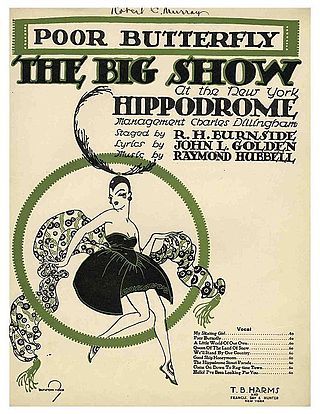"How High the Moon" is a jazz standard with lyrics by Nancy Hamilton and music by Morgan Lewis. It was first featured in the 1940 Broadway revue Two for the Show, where it was sung by Alfred Drake and Frances Comstock. In Two for the Show, this was a rare serious moment in an otherwise humorous revue.

Leroy Anderson was an American composer of short, light concert pieces, many of which were introduced by the Boston Pops Orchestra under the direction of Arthur Fiedler. John Williams described him as "one of the great American masters of light orchestral music."
"Wheel of Fortune" is a popular song written by Bennie Benjamin and George David Weiss and published in 1951. It is best remembered in the 1952 hit version by Kay Starr.
"Blue Tango" is an instrumental composition by Leroy Anderson, written for orchestra in 1951 and published in 1952. It was later turned into a popular song with lyrics by Mitchell Parish. Numerous artists have since covered "Blue Tango".
"Blues in the Night" is a popular blues song which has become a pop standard and is generally considered to be part of the Great American Songbook. The music was written by Harold Arlen, the lyrics by Johnny Mercer, for a 1941 film begun with the working title Hot Nocturne, but finally released as Blues in the Night. The song is sung in the film by William Gillespie.
"So in Love" is a popular song, written by Cole Porter, from his musical Kiss Me, Kate, which was based on Shakespeare's The Taming of the Shrew. It was sung in the show by Patricia Morison, reprised by Alfred Drake, and further popularized by Patti Page in 1949.
A Trumpeter's Lullaby is a short composition for solo trumpet and orchestra, written by American composer Leroy Anderson in 1949. The two and a half minute piece was premiered on May 9, 1950, by the Boston Pops Orchestra with Arthur Fiedler conducting and French-born American Roger Voisin as trumpet soloist. It was composed at the request of Voisin, who was principal trumpeter of the Boston Pops Orchestra at the time. It was first recorded on June 18, 1950, with Fiedler conducting Roger Voisin and the Boston Pops. Three months later it was recorded with Anderson himself conducting and James F. Burke (Musician) as trumpet soloist. The first stereo recording was made in October 1956 with Frederick Fennell conducting the Eastman-Rochester Pops Orchestra, recorded in one take without rehearsal. The (uncredited) soloist was Sidney Mear.
"Tell Me Why" is a popular song written by Marty Gold with the lyrics by Al Alberts. The song was published in 1951.
"Sometimes I'm Happy" is a popular song. The music was written by Vincent Youmans, the lyrics by Irving Caesar. The song was originally published in 1923 under the title "Come On And Pet Me," with lyrics by Oscar Hammerstein II and William Cary Duncan.
"Sleigh Ride" is a light orchestra standard composed by Leroy Anderson. The composer had formed the original idea for the piece during a heat wave in July 1946, and he finished the work in February 1948. The original recordings were instrumental versions. The lyrics, about riding in a sleigh and other fun wintertime activities, were written by Mitchell Parish in 1950. Anderson also made arrangements for wind band and piano.
"A Garden in the Rain" is a popular song. The music was composed by Carroll Gibbons, the lyrics by James Dyrenforth. The song was published in 1928. The song was first recorded by the composer, Carroll Gibbons with the Savoy Hotel Orpheans and vocals by George Metaxa, in July 1928.

"I Found a Million Dollar Baby (in a Five and Ten Cent Store)" is a popular song.
"Hoop-Dee-Doo" is a popular song published in 1950 with music by Milton De Lugg and lyrics by Frank Loesser.
"Lies" is a popular song with music by Harry Barris and lyrics by George E. Springer. It was published in 1931.
"More Than You Know" is a popular song, composed by Vincent Youmans with lyrics by Billy Rose and Edward Eliscu. The song was published in 1929.
"That's My Desire" is a 1931 popular song with music by Helmy Kresa and lyrics by Carroll Loveday.
"I Don't Know Why (I Just Do)" is a 1931 popular song.

"Poor Butterfly" is a popular song. It was inspired by Giacomo Puccini's opera Madame Butterfly and contains a brief musical quote from the Act two duet Tutti i fior in the verse.

"I'm Always Chasing Rainbows" is a popular Vaudeville song. The music is credited to Harry Carroll, but the melody is adapted from Fantaisie-Impromptu by Frédéric Chopin. The lyrics were written by Joseph McCarthy, and the song was published in 1917. It was introduced in the Broadway show Oh, Look! which opened in March 1918. The song was sung in the show by the Dolly Sisters. Judy Garland sang it in the 1941 film Ziegfeld Girl. It was subsequently sung by Jack Oakie in the 1944 film The Merry Monahans and was again featured in the 1945 film The Dolly Sisters, where it was sung by John Payne. It was also included for part of the run of the 1973 revival of Irene.

"You Must Have Been a Beautiful Baby" is a popular song with music by Harry Warren and lyrics by Johnny Mercer, written in 1938 for the Warner Brothers movie Hard to Get, released November 1938, in which it was sung by Dick Powell.




